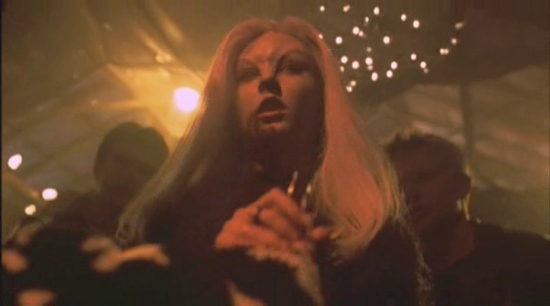
This is your brain.
This is your brain on drugs;

Any questions? Yes, I imagine you have quite a few.
Your brain is so ginger it's called Ginger and she's one of the central characters of a movie called Ginger Snaps, a Canadian horror movie from 2000 that assumes werewolf stories are more interesting if they're just allegories for pubescent drug abuse. Of course, the opposite is true.
Two sisters, Brigitte (Emily Perkins) and the aforementioned Ginger (Katharine Isabelle) are rebellious late bloomers, fifteen and sixteen years old respectively but neither has gotten her period yet. Behaviourally they resist growing up as well, displaying no interest in boys and contempt for any traditionally female behaviour. The two pose for each other in graphic photographs faking their deaths and turn the series in for a class project, an example of their general obsession with the macabre and rebellious.

Ginger changes when she gets her period and a werewolf, smelling the blood, bites her, making her a werewolf too, which means her body goes through frightening changes and she takes an interest in boys. In fact, she becomes rather promiscuous, much to Brigitte's dismay as the two consequently find themselves growing apart as Ginger voyages into experimenting with her body and social identity and Brigitte is stuck behind with hair that looks like a wig.

Wikipedia mentions critics have likened the film to the works of David Cronenberg. A comparison that shows a weak grasp of what distinguishes Cronenberg's films as well as the general point of symbolism in film.
Take, perhaps, the closest Cronenberg approximate to Ginger Snaps--The Fly, a film that also features a character's monstrous transformation and which focuses on how that transformation affects his relationships.
Could we say that Brundle's transformation is a metaphor for drug abuse, for mental illness, for the complicated, inexplicable forces that drive wedges between people? For obsession to the point of self-destruction, the end result of admirable creative or scientific pursuits to which one has dedicated one's life but have only led to ruin? Of course, The Fly can be interpreted as being any of the above because Cronenberg is wise enough not to anchor it to any one. The Fly is the story of a man turning into a giant fly. If you know how to write people, that's all it needs to be to be a meaningful story.
Ginger Snaps, on the other hand, can only be one thing and it's clumsy for it. Is it really helpful to say a girl who likes sex is a monster? Are murder and cannibalism really as bad as drinking too much alcohol? Identifying with monsters in movies is certainly a legitimate way in which to process a story. Stories about monsters can illuminate aspects of human nature. But Ginger Snaps is silly hyperbole.
Sometimes Gregor Samsa turning into an insect is just Gregor Samsa turning into an insect and he means so much more that way.
Twitter Sonnet #510
Tea leaf parachutes absently invade.
Dandelion liaisons drift through blue.
Plywood's exposed where the fake trees were made.
Wire skies take on the vinegar's hue.
Young linoleum watches surgery.
Domestic Justice Leagues laugh at cold wine.
A dull scalpel inks a film forgery.
Mysterious brains so strip tease with twine.
Hell knows brimstones sell when boiled and sweet.
Dark gum is deceitfully hard as stone.
Math rooms locked down for a prisoner's tweet.
Tragic carrots pursued the traffic cone.
Angry ugly oranges ooze mystery.
Sycamores still mind a ghost history.

No comments:
Post a Comment